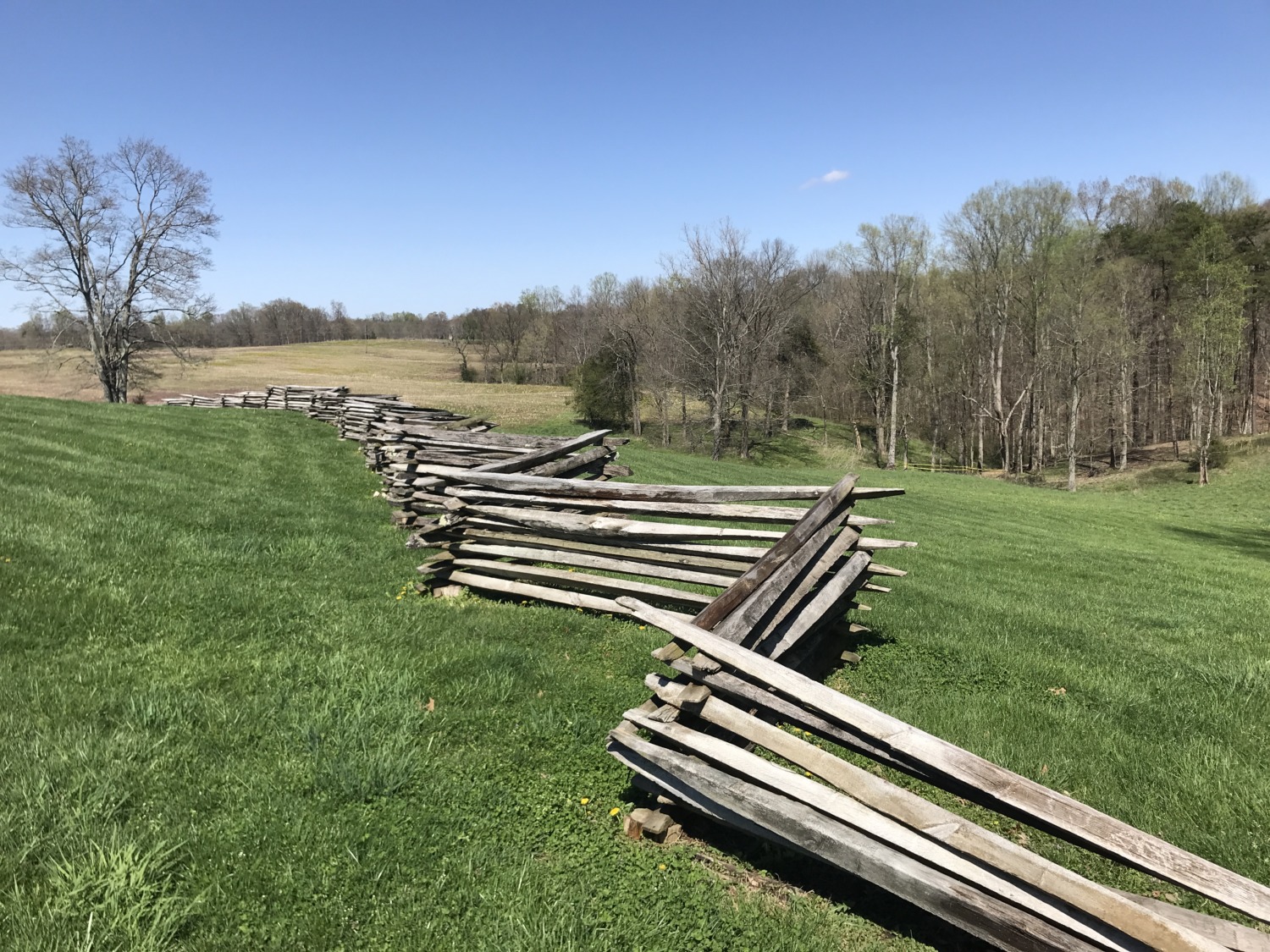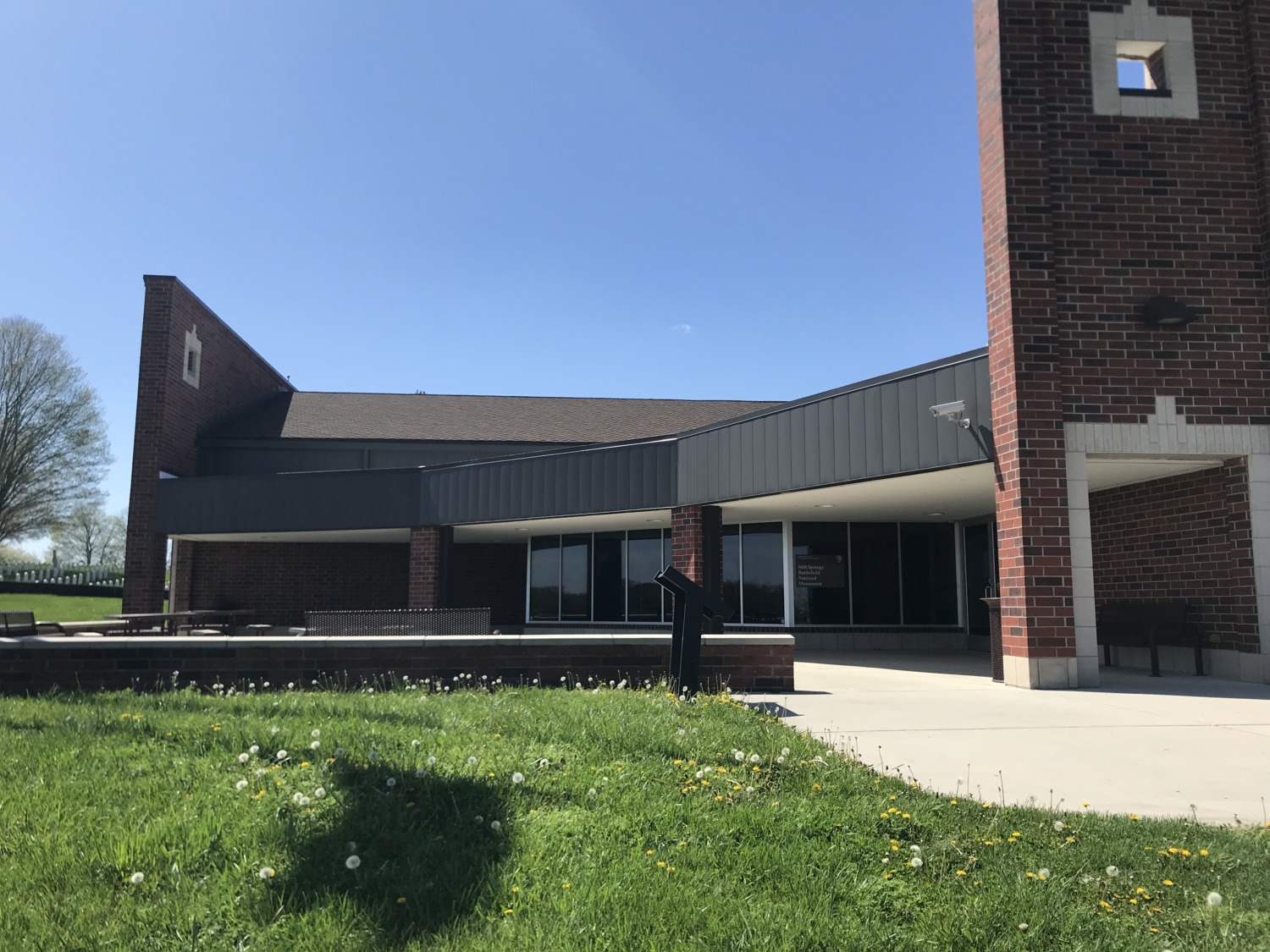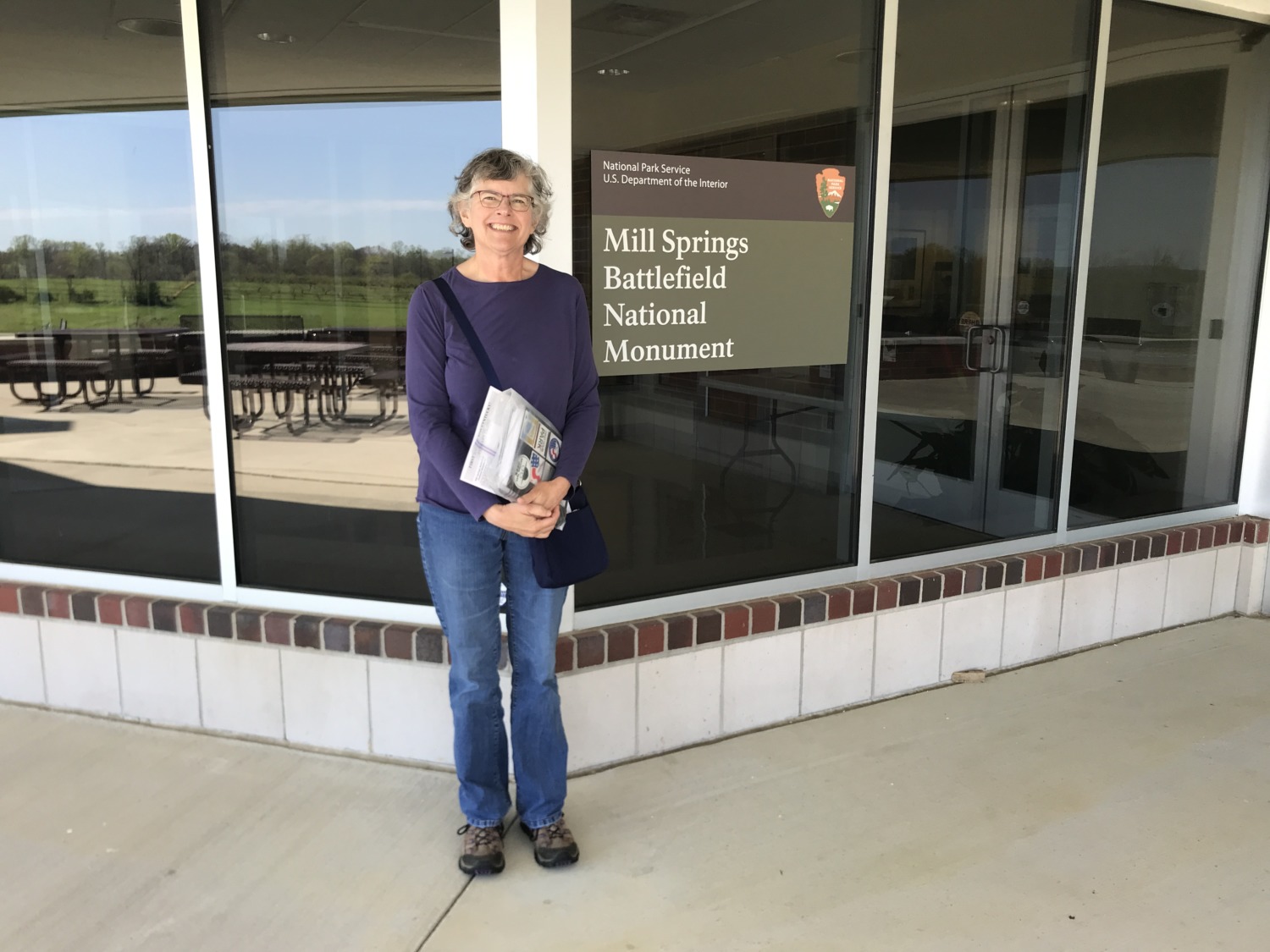Mill Springs Battlefield National Monument is one of the newest National Park sites. It was dedicated on September 2020 after years of advocacy by the Mill Spring Battlefield Association. Thanks to the Association there is a beautiful Visitors Center and a very good museum already in place. Currently, Mill Spring Battlefield National Monument only has one full-time NPS employee, Superintendent Dawn Davis. In addition to Superintendent Davis, the park is being staffed by seasonal rangers, Covid emergency hires, interns, and local volunteers.
Perhaps you have never heard of the Battle of Mill Springs in the Civil War. The following information is taken from an article written by Geoffrey Walden.
At the start of the Civil War, Kentucky declared neutrality. Despite being a slave-owning state, it had close ties to its northern neighbors. When Confederate troops moved into the state, however, the Kentucky state legislature quickly decried the invasion of foreign troops, and decided to side with the Union. Union forces moved in to Kentucky to drive away the Confederate forces and keep Union control in the state.
In October 1861, Brig. Gen. Felix Zollicoffer left Knoxville and moved up through Cumberland Gap, Barbourville, and London. His advance was stopped north of London at Camp Wildcat in the Rockcastle Hills, where the Federals under Brig. Gen. Albin Schoepf repulsed his attack. Zollicoffer moved his forces back into Tennessee and tried a new route into Kentucky, moving up through Monticello to reach Mill Springs on the south bank of Cumberland River in late November. Here he set up camp and fortified his position.
Having decided that the north bank of the river was a better position, Zollicoffer moved his forces across to Beech Grove in early December, putting his regiments into winter camp and digging a line of entrenchments to protect his camp. In early January 1862, Maj. Gen. George B. Crittenden arrived to take command of the forces at Beech Grove. In all, the Confederates had some 6500 men in the area, including cavalry and artillery. The Federals, meanwhile, were concentrating under Gen. Schoepf at Somerset and Brig. Gen. George H. Thomas at Lebanon.
Thomas’ superiors feared that Crittenden’s forces would attack and overwhelm Schoepf (which was, indeed, their plan), so they ordered the Federals to concentrate west of Somerset, near Fishing Creek. Poor weather and bad roads kept Thomas from reaching the area until January 17, when his forces camped at Logan’s Crossroads, a key intersection nine miles west of Somerset and about nine miles north of Zollicoffer’s camp at Beech Grove.
Although the Confederates thought that heavy rains would make Fishing Creek impassable, keeping Schoepf from joining Thomas at Logan’s Crossroads, Schoepf was able to send three infantry regiments and an artillery battery to Thomas’ support, giving the Federals a force of some 4,500 men. Unaware of this reinforcement and wishing to attack the Federals before they could concentrate their strength, Crittenden ordered an advance of the Confederate army at midnight on January 18, 1862. The stage was set for the battle of Mill Springs.
THE BATTLE OF MILL SPRINGS
After marching for six hours through a cold rain that turned the road into a sea of mud, the vanguard of the Confederate force arrived near Logan’s Crossroads about 6:30am on January 19. At the foot of a ridge a mile-and-a-half from the crossroads, the advance Confederate cavalry met a strong picket force of Thomas’ 10th Indiana Infantry and 1st Kentucky Cavalry regiments. Far from being surprised in their camps, the Federals were on the watch, and this picket force stubbornly resisted the Confederate advance up the hill. When they reached the high ground, the pickets were reinforced by the rest of the 10th Indiana, and this force stood its ground against the advancing Confederates.
Crittenden advanced with Zollicoffer’s own brigade in the lead. Zollicoffer put the 15th Mississippi Infantry in line of battle advancing up the road, with his other regiments following. This force was sufficient to push the Federals off the hill and into the woods below. However, the dawn was dark and misty, and the Confederates were spread out for miles along the narrow muddy road, slowing their advance. After fighting for nearly an hour on their own, the 10th Indiana and 1st Kentucky Cavalry were almost out of ammunition and in danger of being overrun. They fell back to a rail fence bordering a corn field, on a low ridge running perpendicular to the road. Here they were finally reinforced by the 4th Kentucky Infantry, and this fence line and ridge formed the basis for the main Federal battle line.

After advancing nearly to the ridgeline on the west of the road, the Confederate advance stalled. Most of the soldiers had never been in a battle before, and the dark rainy morning, coupled with the smoke and din of battle and the lack of visibility in the dense woods, produced quite a bit of confusion. Gen. Zollicoffer, leading his brigade from the front with the 19th Tennessee Infantry, was sure that his men were firing on another Confederate regiment, and he rode forward in the road to reconnoiter. There he met Col. Speed Fry, of the 4th Kentucky, who had ridden to his right for the same purpose. Neither recognized the other (Zollicoffer was said to have been extremely nearsighted, and his own uniform was hidden from Fry’s view by a raincoat), and Zollicoffer ordered Fry to cease firing on his friends.
Fry, assuming Zollicoffer was a Federal officer whom he did not know, and also unsure of who the troops to his right were, answered that he would never intentionally fire on a friendly unit. As Fry moved back toward his own regiment, Capt. Henry Fogg of Zollicoffer’s staff suddenly rode out of the woods to warn Zollicoffer, firing his pistol at Fry. Fry and the Union soldiers near him immediately returned the fire, and Zollicoffer fell dead in the road. (Capt. Fogg was also killed in the battle, probably at this time.)

Zollicoffer’s death threw his troops on that part of the field into confusion, and with no brigade commander to lead them, they made no further significant advances on the west of the road. However, the 15th Mississippi and 20th Tennessee regiments launched a series of furious attacks on Fry’s position, some even reaching the fence, where they fought the Federals hand-to-hand. Bayonets were poked through the fence rails, and the Mississippians attacked swinging their long “cane” knives.
The Confederates moved ever toward their right, threatening to turn the Federal left flank. But a section of Federal artillery appeared at the crucial moment and threw shells toward the Confederates, and the 2nd Minnesota and 9th Ohio regiments arrived to bolster the Union defenses. The Federals now had over four regiments at the point of action, opposing three Confederate regiments in direct contact with their enemy — less than ideal odds for the Southern attackers.
For over an hour, the 15th Mississippi and 20th Tennessee battled the Federals almost alone. Rutledge’s Confederate artillery fired a few rounds, and the 25th and 28th Tennessee regiments moved up to reinforce the troops fighting on the front line, but Crittenden was never able to bring up all the rest of his infantry and bring all of his forces to bear. Nor did he make use of his cavalry for any flanking movements. (Crittenden was severely criticized for his handling of the battle, and indeed, he may have been drinking at the time. He resigned his commission later in 1862.)
The Confederates were further demoralized by the failure of many of their weapons to fire in the intermittent rain. Most of the Confederate force, particularly the Tennessee regiments, were armed with obsolete flintlock muskets. Only the 15th Mississippi, 16th Alabama, and 29th Tennessee were partially armed with percussion muskets and rifles. One participant estimated that only a fifth of the Confederate muskets would fire. In their frustration, many of the Tennesseans were seen to smash their useless flintlocks against trees.
In contrast to the Confederates, the Federals were finally able to concentrate their forces. The 1st and 2nd Tennessee and 12th Kentucky US regiments arrived to outflank and outnumber the hard fighting 15th Mississippi and 20th Tennessee, and Gen. Thomas, sensing the imminent collapse of the Confederate line, ordered a general advance of the Union force. The 9th Ohio Infantry, a German regiment from Cincinnati, charged the Confederates with fixed bayonets. The Confederate left crumbled under the Ohioans’ bayonet charge, and the 15th Mississippi and 20th Tennessee were forced to retreat to keep from being surrounded.
The entire Union line advanced, forcing what was left of the Confederate army back to the top of the hill from which they had attacked. Here, the 16th Alabama and 17th and 29th Tennessee regiments opened a heavy fire on the Federals, momentarily halting their pursuit and allowing the front-line Confederate units to safely retreat. But for most of the Southern soldiers, their retreat turned into a rout. Their courage and determination were simply not enough to overcome their outmoded flintlocks and the confusion and lack of decisive leadership at their command level. After some three or four hours of hard fighting on a dark, rainy morning, the battle was over.
AFTERMATH
The outmatched Southerners withdrew back down the road toward their camps. They rallied at their Beech Grove entrenchments, but Gen. Thomas arrived with his forces in the afternoon and promptly opened a bombardment on the Confederate camp, including a steamboat on the river below. With their backs to the river, this steamboat was the Confederates’ only lifeline for any withdrawal. Recognizing that his position was untenable, Crittenden ordered a withdrawal across the river that night.
The Confederates left behind all of their artillery pieces and wagons, and most of their horses and camp equipment. When dawn on January 20th arrived and the Federals moved against the Confederate works, they found the camps abandoned and Crittenden’s force safely across the river. The Federal forces reported 246 casualties of the battle, including 39 killed in action (most of these are buried in the Mill Springs National Cemetery in Nancy). The Confederates suffered 533 casualties, including more than 120 killed in action. The bodies of Gen. Zollicoffer and Lt. Peyton were returned to their families, who had them buried with honor in Nashville. The remaining Southern dead were left on the field to be buried in mass graves, many near the site of Zollicoffer’s death.
Coupled with the Confederate losses of Forts Henry and Donelson less than a month later, the Union victory at Mill Springs cracked the Southern defense line in Kentucky.
OUR VISIT
When Tom and I arrived at Mill Spring Battlefield, we immediately watched the excellent movie about the battle. Because we didn’t know anything about the history, this was a good introduction. Then we wandered around the museum, learning more details about each side’s movements. We took our time, because one of our reasons for coming to Mill Springs was to see Ranger Caitlyn. She was on a one-month detail to help get the park set up. She had to work until 5, so we could take our time looking around.

After looking at everything in the museum we took part of the driving tour. The tour has ten stops. Stops 1-5 are part of the Battle of Mill Springs, and Stops 6-10 deal with the southern retreat and northern pursuit. We saw the National Cemetery next door where the Union soldiers killed in the battle are buried. Then we went to Zolicoffer Park where the majority of the fighting took place. We walked along the picket fence where the Union soldiers took their stand. We saw the spot where Zolicoffer died and the woods where the southern forces gathered and the cannon on Last Stand Hill.
Our visit to Mill Springs Battlefield was very interesting as we learned a little more Civil War history. The Association did an excellent job of preserving and protecting the site. I hope the National Park Service can carry on the site at the same level.

